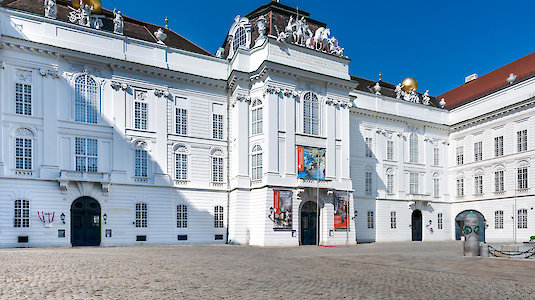The Austrian National Library: A "bridge" between past and future
Museums, archives and libraries see themselves as bridges between the past and the present - with perspectives on the future for which they provide important impulses. In order to make this concern visible to the outside world, there is the Austrian Ecolabel. That is why the Austrian National Library in Vienna also applied for the state seal of quality.
What Austria was and is.
The Austrian National Library (https://www.onb.ac.at/) is the largest library and the central memory store of the Republic. Eight collections of the building are also dedicated to Austria's diverse cultural heritage (https://www.onb.ac.at/bibliothek/sammlungen). At the same time, the National Library is a historical building that can be visited (keyword "baroque state hall"), but also houses five museums (https://www.onb.ac.at/museen). A wide variety of demands are therefore placed not only on the architecture as a workplace but also as a place of information, education and research for numerous users.
What Austria will be.
We spoke to Dr. Johanna Rachinger at the Austrian National Library. She is the Library's Director General and explains: "With the Austrian Ecolabel, the Austrian National Library wants to give a visible sign of its commitment to the environment." The Austrian National Library preserves Austria's cultural past, but at the same time it is a future-oriented information, education and research centre. It therefore sees itself as a "bridge" between the past and the future - and therefore also wants to provide impulses in the area of sustainability. And the Austrian Ecolabel is an excellent way of communicating corresponding values to the public.

Ecological sustainability & committed monument protection.
Certification with the Austrian Ecolabel also requires a "climate-fit" museum building. But how can the historic building that houses the Austrian National Library be made "climate-fit"? Johanna Rachinger answers: "The biggest challenge in terms of ecological sustainability is that the Austrian National Library is located in the Vienna Hofburg. The Hofburg is a heritage-listed building. Thermal insulation of the outer facade or replacement of the windows is not economically feasible for these reasons. Moreover, many of these points are the responsibility of the landlord, the Burghauptmannschaft Österreich as representative of the Republic."
However, much is being done in the building itself with regard to climate protection: for example, "the heating temperature is always lowered at night via the building management system. However, a general reduction of the heating temperature in all areas of the Austrian National Library is not possible. This is because a constant temperature and humidity is necessary in the depots and stacks due to restoration requirements," Johanna Rachinger reports. And adds: "Motion detectors and timers for the efficient use of lighting systems are partly in use in the restrooms, in the book depository as well as in the outdoor areas."

Barrier-free access to the books.
The Austrian National Library can also score points in the area of "accessibility": "One focus of the comprehensive investment programme 2020 was the improvement of barrier-free access in the customer areas of the library. On the one hand, the investments concern structural measures to make the accesses and staircases in the interior as well as wardrobes, lockers and service desks barrier-free. In addition, the sanitary facilities in the user areas were adapted and equipped for the disabled and diaper-changing tables were added."

Cycling to the library.
In principle, all facilities of the Austrian National Library are easily accessible by public transport for visitors and staff. In order to make it more attractive for staff to travel to the library by bicycle and to make their working day more pleasant, shower facilities were installed for them in the National Library in 2020. "These shower facilities are intended to motivate employees to make their way to work sporty and emission-free." And they can then attend to the visitors in a correspondingly "refreshed" manner. A very good idea. But the National Library is promoting the journey by bicycle even more: this year, for the first time, there will be a bicycle check day. "On this day, staff members' bicycles will be checked for roadworthiness free of charge and will be able to undergo a small service," Johanna Rachinger is pleased to announce.

Quality feature.
With these considerations and measures, the Austrian National Library is increasingly concerned with the world around it, i.e. with the "environment". It thus fulfils an ecological educational mandate and can communicate this more clearly to the outside world with the Austrian Ecolabel.
It is to be welcomed if other Austrian museums follow the example of the country's largest library and set out to acquire the Austrian Ecolabel as an additional proof of quality.

Author: Dr. Helmuth Öhler
IMAGE:
2 photos on the subject of "Reading rooms with insulating glass":
Main Reading Room, Heldenplatz, Neue Burg, 1010 Vienna © Austrian National Library/Pichler
Austriaca Reading Room, Heldenplatz, Neue Burg, 1010 Vienna © Austrian National Library/Pichler
1 Photo on the subject of "constant temperature and humidity in the depots":
Book depository, Neue Burg, 1010 Vienna © Austrian National Library/Pichler
2 photos on the subject of "listed buildings":
Josefsplatz 1, 1010 Vienna © Austrian National Library/Pichler
Neue Burg, Heldenplatz, 1010 Vienna © Austrian National Library/Pichler © Austrian National Library/Pichler
